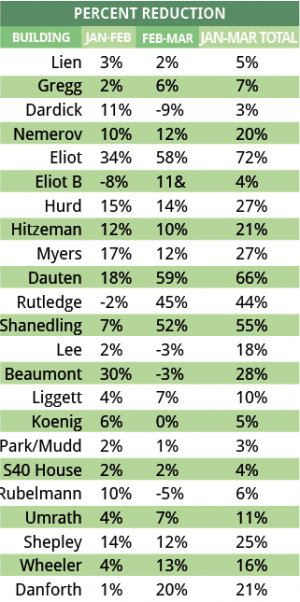Campus Events
Apparent energy reductions follow Green Cup
In the month after the Green Cup finished, energy use in on-campus dorms continued to fall, according to figures released by the Office of Sustainability earlier this week.
The figures show a reduction in energy use in March compared to January in every on-campus dorm, with many dorms reducing use in March compared even to February, when the Green Cup was going on.
The Green Cup Competition pits residential colleges against each other in a competition to reduce energy usage. It took place throughout the month of February. The Lee/Beaumont Residential College won the South 40 competition while the Sigma Chi fraternity won the fraternity competition.
While the results seem conclusive, Will Fischer, Washington University’s sustainability coordinator, warned that the numbers are imperfect, not fully taking into account spring or winter breaks (which cut into January and March but not February). He also said that the warm weather in March might have contributed to the low numbers for that month as students did not have to turn the heat on as much as in January or February.
“The discrepancy in weather patterns probably has a pretty sizable effect on the data, but we still are seeing some pretty impressive numbers,” Fischer said. “It looks like the students are continuing to turn things off, but they’re not continuing to do crazy things to keep energy usage down.”
Some residential colleges made such extreme efforts to win the Green Cup—such as turning off the heat or having a sleepover on the first floor so all the lights could be off—that the energy savings have been unsustainable. Similarly, Eliot Hall is the only building with electric heating, throwing off its statistics completely. Danforth Hall’s numbers are skewed because it is connected to the pathway lighting on the streets.
Still, the Office of Sustainability and participating students said that since the Green Cup, students have changed their behaviors for the greener.
“During the Green Cup, we were all really into it,” freshman Karen Gitlin, who lives in Beaumont Hall, said. “But even now after it’s over, there are still a lot of people on my floor who are doing it, and some of the lights in the hallway are always being turned off.”
Some students said the changes in their peers’ green behavior to have been more substantive.
“We do it for a month, so hopefully turning off electronics, unplugging appliances and chargers, etc., becomes a habit,” sophomore Katie Gong said. “I know that people started using surge protectors and began using CFLs [compact fluorescent lights], and they will probably continue to use them.”
The Office of Sustainability hopes to post periodic reports of how much energy each building or residential college is using relative to the amounts they used during the Green Cup because the meters used during the competition are still in place in all the buildings and dormitories, according to Phil Valko, director of sustainability.
Valko emphasized that the Green Cup is just a part of the continuing efforts to reduce the carbon footprint of the Danforth Campus.
“The Green Cup is focused on educating the student body on energy awareness to the student body,” Valko said. “This is only the second year we’ve done it, and the hope is that we’ll be doing it more broadly across campus, creating a culture of energy awareness and each year improving it.”
The measurements taken this year were much more precise than last year, Valko said.
He said the next step in reducing the campus’ carbon footprint is to seek renewable energy sources. The University recently approved a renewable energy task force, which will be comprised of students, faculty and staff, and will be charged with finding feasible opportunities for renewable energy use.
“If you’ve got a building with a huge energy footprint, renewable can only provide so much energy,” said Valko. “The University still wants energy conservation to be first and foremost, which makes sense.”

